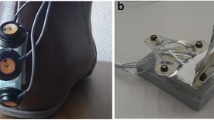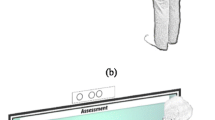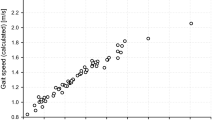Abstract
Background and aims
Avoiding falls requires fast and appropriate step responses in real-life situations. We developed a step-tracking device that uses an infrared laser sensor for convenient assessment of stepping performance, including concurrent assessment of temporal and spatial parameters. In the present study, we created a new index for assessment of fall risk that uses step speed and accuracy measurements. The purpose of this study was to determine whether the new index could discriminate between elderly individuals with different risks of falling.
Methods
One hundred and fifty-two community-dwelling elderly individuals (73.9 ± 4.6 years) participated and performed stepping tasks as quickly as possible on a plus-shaped mat in response to optical cues. The step-tracking device with the infrared sensor detected the motion and position of both legs in the step field. The device recorded temporal and spatial parameters, foot-off and foot-contact time, step length, and the percentage of correctly executed steps. We used the coefficients of a logistic regression model to develop “stepping-response score” based on the weighted sum of these temporal and spatial parameters.
Results
The faller group had significantly worse stepping-response score than the non-faller group (p < 0.001). A stepwise logistic regression analysis demonstrated that stepping-response score was independently associated with falling (odds ratio = 0.15; p < 0.001). The ROC curve had a moderate AUC (0.73) for stepping-response score (sensitivity 73.0 %; specificity 69.7 %).
Conclusions
This study indicates that the stepping-response score calculated from measurements obtained using the new step-tracking device can identify elderly individuals who are at a risk of falling.

Similar content being viewed by others
References
Tinetti M, Speechley M, Ginter S (1988) Risk-factors for falls among elderly persons living in the community. N Engl J Med 319(26):1701–1707
Blake AJ, Morgan K, Bendall MJ et al (1988) Falls by elderly people at home: prevalence and associated factors. Age Ageing 17(6):365–372
AGS Guideline (2001) Guideline for the prevention of falls in older persons. American Geriatrics Society, British Geriatrics Society, and American Academy of Orthopaedic Surgeons Panel on Falls Prevention. J Am Geriatr Soc 49(5):664–672
St George RJ, Fitzpatrick RC, Rogers MW et al (2007) Choice stepping response and transfer times: effects of age, fall risk, and secondary tasks. J Gerontol A Biol Sci Med Sci 62(5):537–542
Melzer I, Kurz I, Shahar D et al (2007) Application of the voluntary step execution test to identify elderly fallers. Age Ageing 36(5):532–537
Pijnappels M, Delbaere K, Sturnieks DL et al (2010) The association between choice stepping reaction time and falls in older adults—a path analysis model. Age Ageing 39(1):99–104
Melzer I, Oddsson LI (2004) The effect of a cognitive task on voluntary step execution in healthy elderly and young individuals. J Am Geriatr Soc 52(8):1255–1262
Lord SR, Fitzpatrick RC (2001) Choice stepping reaction time: a composite measure of falls risk in older people. J Gerontol A Biol Sci Med Sci 56(10):M627–M632
Woolley SM, Czaja SJ, Drury CG (1997) An assessment of falls in elderly men and women. J Gerontol A Biol Sci Med Sci 52(2):M80–M87
Lord SR, Clark RD (1996) Simple physiological and clinical tests for the accurate prediction of falling in older people. Gerontology 42(4):199–203
Lindemann U, Lundin-Olsson L, Hauer K et al (2008) Maximum step length as a potential screening tool for falls in non-disabled older adults living in the community. Aging Clin Exp Res 20(5):394–399
Yamada M, Higuchi T, Tanaka B et al (2011) Measurements of stepping accuracy in a multitarget stepping task as a potential indicator of fall risk in elderly individuals. J Gerontol A Biol Sci Med Sci 66(9):994–1000
Kalbe E, Calabrese P, Schwalen S et al (2003) The Rapid Dementia Screening Test (RDST): a new economical tool for detecting possible patients with dementia. Dement Geriatr Cogn Disord 16(4):193–199
Koski K, Luukinen H, Laippala P et al (1996) Physiological factors and medications as predictors of injurious falls by elderly people: a prospective population-based study. Age Ageing 25(1):29–38
Lopopolo RB, Greco M, Sullivan D et al (2006) Effect of therapeutic exercise on gait speed in community-dwelling elderly people: a meta-analysis. Phys Ther 86(4):520–540
Podsiadlo D, Richardson S (1991) The timed “Up & Go”: a test of basic functional mobility for frail elderly persons. J Am Geriatr Soc 39(2):142–148
Guralnik JM, Simonsick EM, Ferrucci L et al (1994) A short physical performance battery assessing lower extremity function: association with self-reported disability and prediction of mortality and nursing home admission. J Gerontol 49(2):M85–M94
Troyer AK, Moscovitch M, Winocur G et al (1998) Clustering and switching on verbal fluency tests in Alzheimer’s and Parkinson’s disease. J Int Neuropsychol Soc 4(2):137–143
Cerhan JH, Ivnik RJ, Smith GE et al (2002) Diagnostic utility of letter fluency, category fluency, and fluency difference scores in Alzheimer’s disease. Clin Neuropsychol 16(1):35–42
Bellotto N, Hu H (2009) Multisensor-based human detection and tracking for mobile service robots. IEEE Trans Syst Man Cybern B Cybern 39(1):167–181
Schoene D, Lord SR, Verhoef P et al (2011) A novel video game-based device for measuring stepping performance and fall risk in older people. Arch Phys Med Rehabil 92(6):947–953
Melzer I, Kurz I, Shahar D et al (2010) Do voluntary step reactions in dual task conditions have an added value over single task for fall prediction? A prospective study. Aging Clin Exp Res 22(5–6):360–366
Melzer I, Oddsson LI (2013) Improving balance control and self-reported lower extremity function in community-dwelling older adults: a randomized control trial. Clin Rehabil 27(3):195–206
Pichierri G, Coppe A, Lorenzetti S et al (2012) The effect of a cognitive–motor intervention on voluntary step execution under single and dual task conditions in older adults: a randomized controlled pilot study. Clin Interv Aging 7:175–184
Silsupadol P, Siu KC, Shumway-Cook A et al (2006) Training of balance under single- and dual-task conditions in older adults with balance impairment. Phys Ther 86(2):269–281
Yamada M, Tanaka B, Nagai K et al (2011) Rhythmic stepping exercise under cognitive conditions improves fall risk factors in community-dwelling older adults: preliminary results of a cluster-randomized controlled trial. Aging Ment Health 15(5):647–653
Yamada M, Aoyama T, Arai H et al (2011) Dual-task walk is a reliable predictor of falls in robust elderly adults. J Am Geriatr Soc 59(1):163–164
Acknowledgments
We would like to thank the students at the Department of Human Health Sciences at Kyoto University for their help with data collection. We would also like to acknowledge Murata Machinery, Ltd. and the students of Keio University for their contributions to device development.
Conflict of interest
None.
Author information
Authors and Affiliations
Corresponding author
Rights and permissions
About this article
Cite this article
Nishiguchi, S., Yamada, M., Uemura, K. et al. A novel infrared laser device that measures multilateral parameters of stepping performance for assessment of all risk in elderly individuals. Aging Clin Exp Res 25, 311–316 (2013). https://doi.org/10.1007/s40520-013-0042-9
Received:
Accepted:
Published:
Issue Date:
DOI: https://doi.org/10.1007/s40520-013-0042-9




